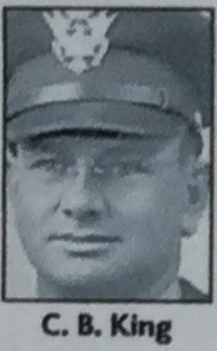C. B “Boots” King
Flight Officer - T–120663

CLOSE
Go to all glider pilots KIA
C. B “Boots” King
|  |
 |
Flight Officer C. B. “Boots” King, T–120663, received his flight training at Dalhart AAF base, Class of 43-1, Graduated on January 6, 1943. C.B. “Boots” King: Tahoka’s WWII Combat Glider PilotBy Dr. Donald Abbe, Curator, Silent Wings Museum
Published in the Silent Wings Museum Newsletter, Winter 2014. During World War II many new military tactics were used to fight the war. One of the best known was the use of paratroopers, by the thousands, in operations known as “vertical envelopments”. Most of the belligerents in the war used airborne troops, but the U.S. and the British were the most committed advocates of the strategy. The idea of surrounding and disrupting the enemy from above played a major role in Allied invasions into hostile territory, such as at Normandy, into Holland, and finally into Germany. For these airborne operations to have any chance of success the Army needed a way to deliver heavy equipment and supplies to the airborne as soon as they were on the ground. The tool of choice was the cargo glider (or combat glider if you flew one into harm’s way). Essentially a large box with wings, the cargo glider could carry everything from Jeeps and trailers to artillery pieces, additional troops, ammunition, mortar teams, machine gun teams or medical teams, the list is endless. Flying the gliders into combat was a very dangerous process. They were totally defenseless, with no armor of any kind. When they landed in combat zones they flew in low and slow, making perfect targets for ground fire. Most landings in combat zones were little more than controlled crashes. Only about 6,000 men were trained as glider pilots during WWII. One of them was C.B. “;Boots” King. C.B King, from the small town of Tahoka, Texas, was one of four brothers who entered the U.S. military when war broke out. His brothers served across the globe. Sgt. Bill King was in England by mid–1944, Jack King was in the Navy, “somewhere at sea”, Lt. Lee King was dead, killed in the China-Burma-India theater by mid 1944. C. B. was also in England by the spring of 1944. C.B. entered the US Army in February of 1942, initially sent to Lubbock Army Airfield to be trained as a crew member and mechanic. He volunteered for the Army glider program and was training in Plainview in July of 1942. He then moved to Ft. Sumner, New Mexico for his next round of training, finishing that section on August 16th, 1942. From there he went to Dalhart, Texas for his Advanced glider training, winning his Glider Pilot “G” Wings in January, 1943. From Dalhart King went to the Sedalia Army Airfield for further training, and then on to Laurenburg–Maxton AAF in North Carolina for final tactical training. Finally, he was shipped to England for his permanent assignment to the 439th Troop Carrier Group; 92nd Squadron. King was a bit older than most glider pilots, and was married. His wife lived in O’Donnell, Texas, about 13 miles south of Tahoka, while he trained. Tragedy entered King’s life in 1943, shortly before he went overseas, as his wife died in childbirth. The healthy baby girl was taken by Mr. and Mrs. J.W. Lowrey, part of his wife’s family. By the time King arrived in England he was a widower with a very uncertain future. On June 6, 1944 he flew a glider (one of over 900 sent out) into the maelstrom known as the Normandy invasion, receiving severe facial cuts and a broken finger during his landing. On August 14, 1944 he flew one of over 450 gliders into Southern France as part of the airborne operations of that invasion. Then, in September of 1944, he flew into Holland in the huge and chaotic Operation Market–Garden. Over 2,500 gliders were sent into Holland over a 10 day period in September. So far, King’s luck was holding; three major airborne invasions and only minor injuries as a result. The last major airborne operation of the war, Operation Varsity, came on March 24th, 1945. Two entire airborne divisions were dropped across the Rhine River near Wesel Germany. Over 1,300 gliders went into landing zones which were hotly contested when they landed. During the chaos of the landing, when all gliders were under fire before, during and after landing, a number of glider pilots were killed. The official post-operation military interview with King’s co-pilot tell us that the glider King was piloting was first hit in the belly by flak, just as it cut loose from the tug. The glider was on fire as it landed, and as it touched down a large caliber shell struck the glider. By the time it stopped the glider was on fire from end to end. F/O Ring kicked out the center section of the nose, crawled out and hit the dirt. A burning King clambered from the glider and was immediately cut down by enemy fire. Three of the Glider Infantry were killed, the fourth wounded. “Boots” King’s luck finally ran out. [Details of this operation as written in 1945] He was buried in Europe, but his remains were transferred to Tahoka, Texas between 1946 and 1948. Next of kin listed as recipient of the remains was W.L. King of Tahoka. C.B. King is buried in the Tahoka cemetery.
Awards included: Air Medal, 3 Oak Leaf Clusters , purple heart
Researched by Patricia Overman, Member of the Research Team Material complied by the National WWII Gilder Pilot&srquo;s Research Team
|
CLOSE
Go to all glider pilots KIA